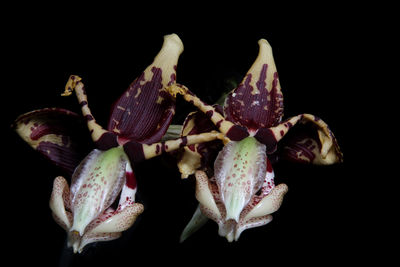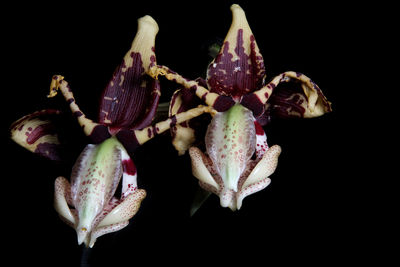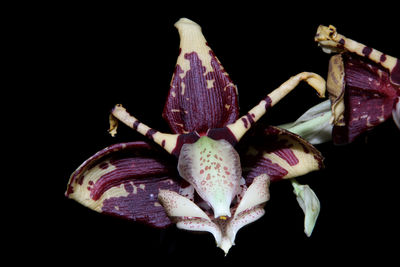-
General Description
-
The spectacular and heavily scented tiger-spotted stanhopea has, as the name suggests, large flowers marked with distinctive purplish-brown streaks and stripes on a yellowish background.
The genus Stanhopea was named by Sir William Hooker, Director of Kew, to commemorate the Rt Hon. Philip Henry Stanhope, President of the Royal Medico-Botanical Society of London from 1829 until 1837. There are over 60 species in the genus, most of which occur in tropical South and Central America.
Stanhopea tigrina was first described in 1837 by James Bateman (1811-1897) in his monumental 10 volume work, The Orchidaceae of Mexico and Guatemala. Bateman was Vice-President of the Royal Horticultural Society and a keen grower of tropical orchids. Bateman's books were instrumental in stimulating interest in orchids and orchid growing in Britain in the 19th century. The type plant he described was collected by John Henchman in Mexico, and the image in Curtis's Botanical Magazine shows a plant painted by Walter Hood Fitch in 1850, by which time 'the species is now not uncommon in our collections, and is said to have been introduced to them by Messrs. Low, of Clapton, from Xalapa in Mexico.'
-
Species Profile
-
Geography and distribution
Stanhopea tigrina is found only in Mexico.
Description
Overview: Stanhopea tigrina is an epiphytic orchid.
Leaves: Upright, oblong leaves (35 cm long and 10 cm wide), each arise from a single pseudobulb, which form tight clusters.
Flowers:The large flowers are scented and produced in groups of 2-4 in a pendulous inflorescence up to 15 cm long. Individual flowers have yellow petals and sepals and are heavily spotted and streaked purplish-brown. Each sepal is reflexed (bent backwards) and measures up to 8.0 cm long and 5.0 cm wide. The petals are around 7.0 cm long and 1.5 cm wide.
Pollination is by male euglossine bees (also known as orchid bees), which collect floral fragrance compounds from the lip of the flowers.
Threats and conservation
Not evaluated according to present IUCN Red List criteria, but Stanhopea tigrina was formerly listed as Vulnerable (V) by IUCN. Stanhopea tigrina is also listed in Appendix II of CITES to help ensure international trade is monitored and controlled.
Uses
Tiger-spotted stanhopea is cultivated as an ornamental. The flowers of Stanhopea tigrina were sometimes used to flavour tortillas.
Cultivation
Tiger-spotted stanhopea has large showy scented flowers, each of which last only two to three days. As these occur on pendulous stems, the plant needs to be grown in a hanging basket to mimic its natural growth. Propagation is by seed or division.
This species at Kew
Tiger-spotted stanhopea can be seen in the Princess of Wales Conservatory when in flower, normally in late summer or early autumn.
Pressed and dried, and alcohol-preserved specimens of Stanhopea tigrina are held in Kew's Herbarium, where they are available to researchers from around the world, by appointment. The details of some of these, including an image, can be seen online in the Herbarium Catalogue.
-
Distribution
-
Mexico
-
Ecology
-
Rainforests.
-
Conservation
-
Not evaluated according to present IUCN Red List criteria, but formerly listed as Vulnerable (V) by IUCN. Listed in Appendix II of CITES.
-
Hazards
-
None known.









